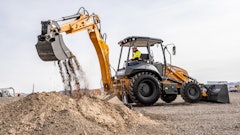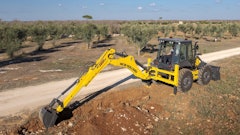At Utility Expo 2021 John Deere took the wraps off its prototype electric backhoe, the 310 X-Tier.
Deere announced development of this machine back in January. But Utility Expo was the first time anyone has had a chance to see and hear this extremely quiet backhoe up close.
It’s also the first time we’ve seen this model name: 310 X. The X is the highest tier in Deere’s new performance tiering nomenclature for its machines. It’s used to denote hybrid and electric machines and represents Deere’s latest and greatest technology.
And beyond the fact that this is a battery-powered machine, the other interesting aspect of the machine's development is that it's being tested with the help of National Grid, one of the world's largest utility companies, serving 20 million+ customers throughout the northeast U.S.
Which makes the Utility Expo a natural fit for this machine’s debut. However, just to reiterate: as of right now, the 310 X on display at the show is just a prototype. But it is the prototype. This is the machine that made its way onto several National Grid job sites throughout the spring and summer of this year.
But why did Deere choose a backhoe for a first battery-powered machine? And specifically, why the 310? It all goes back to this partnership with National Grid. See, the 310 X was basically National Grid’s idea to begin with.
Deere says the company approached them a few years back and asked if the equipment maker would be interested in developing an electric 310.
National Grid has a particular fondness for the 310 model. After all, as a natural gas and electric provider, National Grid is mostly performing shallow trenching, making the 310’s 14-feet of dig depth, plus 25 mph of top speed and self transport a perfect solution.
So, Deere has essentially taken a 310—a current but established tractor design—they’ve removed the exhaust stack and engine and thrown a battery array under the hood. To do that, Deere has worked with a few different suppliers in sourcing the battery technology at the heart of this backhoe. However, they aren’t yet making public just who those suppliers are.
That battery technology is designed to provide the 310 X with enough power to match the diesel-powered 310L, spec-for-spec.
The 310L is a 100-hp machine with 14-feet of max dig depth, 9300 lb-ft of bucket breakout and 28 gallons per minute of hydraulic flow. So far, it looks like the 310X has been able to match the 310L’s capability.
National Grid operators have told Deere that the battery-powered X-Tier controls, operates and performs pretty much identically to the diesel-powered version.
But I know one of the biggest questions on the minds of contractors and operators out there concerns runtime. Just how long is this machine going to work in the field before you have to stop and charge it up? Deere knows that and during my visit at the show told me that they see development of this machine as more of a years-long process.
The company says it's unlikely they'll go to market with the 310 X unless they are able to get a runtime of at least 8-10 hours between charges.
Just as Deere isn’t ready to detail who they’re working with on the battery side, they also tell me it’s too early to give specifics on the battery array itself inside this machine. So, as of right now we don’t know the actual capacity, rating or run time of the battery at the heart of this machine. We just know that it isn’t yet at that 8-10-hour runtime target that Deere has set for itself.
The other thing to keep in mind is that when/if the 310 X comes to market, it might not be this exact design that is produced. As Deere makes tweaks and changes components with the aim of hitting that runtime target, the resulting machine could veer further away from he 310L design that it is heavily founded on.
But the battery is really only half of that runtime equation. Charging is the other half. To that end, Deere is testing multiple methods of power delivery including fast chargers and mobile quick chargers. Think really big versions of those portable battery packs we charge our phones with. But in this case, you’re topping up a backhoe with it.
Of course, removing an engine from a machine packs more than just the benefit of eliminating emissions from burning fuel. There’s also noise and cost to consider. On the noise front, the battery-powered 310 X is anywhere from 20-25% quieter than the diesel-powered 310L. Take a listen to just how quiet this machine is.
Not only is that quieter machine easier on the operator’s ears, it also means you can work at times or places a louder machine wouldn’t be welcome, such as confined spaces, urban job sites, or sites near schools and hospitals.
Beyond fuel and noise emissions, the other big reason to consider the 310 X—should it come to market—is the savings with respect to cost of ownership, as an electric machine is much easier to maintain than one with an internal combustion engine.


![Jd E Power Backhoe 300dpi[1][2]](https://img.forconstructionpros.com/files/base/acbm/fcp/image/2021/01/JD_E_Power_Backhoe_300dpi_1__2_.5ff5eac44767e.5ff5eb4785930.png?auto=format%2Ccompress&fit=crop&h=75&q=70&rect=0%2C87%2C1920%2C1080&w=75)


























